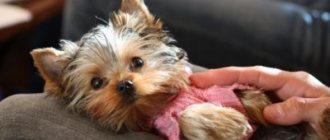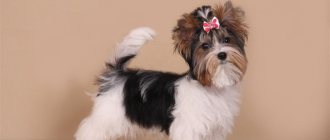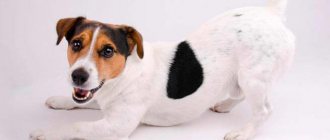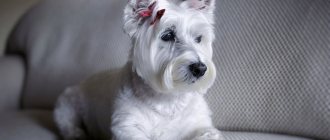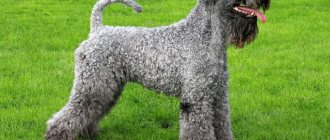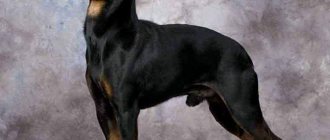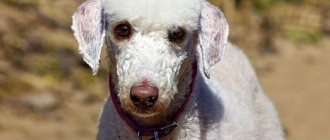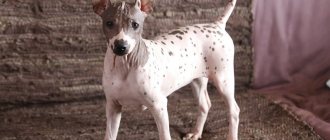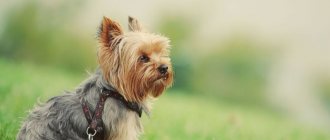Breed characteristics
| Short description | |
| Origin: | England (Yorkshire) |
| Conditions of detention: | Apartment, house without garden |
| Purpose: | Decorative dog, companion dog |
| Color: | Body: black, steel, silver; head and paws: brown, silver beige |
| Wool length: | Long |
| Adult dog size: | Height 18-20 cm, weight up to 3.2 kg |
| Average life expectancy: | 11-15 years |
| Walk: | Desirable (2 times a day) |
| Physical activity needs: | Average physical activity needs (walking 1 to 3 hours per day) |
| Fédération Cynologique Internationale (FIC) classification: | Group 3: Terriers; Section 4: Toy Terriers |
| Puppy price: | 7500-30000 rubles |
History of the origin of the species
Yorkshire terriers appeared not so long ago, in the 18th and 19th centuries. There is no clear answer to the question of who developed the breed and why. There are several hypotheses. According to one of them, the first ancestors of modern Yorkies were bred by mine workers in West Riding so that the dogs could catch rats and find accumulations of gases. Since these terriers were miniature, they were easily carried in a jacket and work clothes to circumvent the ban on the presence of various animals in the mines.
According to the second version, small terriers were bred by farmers and peasants to save their homes from rodents. The feudal lords did not allow people to keep large dogs in order to avoid poaching and hunting on their lands. Such small pets became not only good rat catchers, but also companions. They were called Waterside Terriers.
Active urbanization and industrialization contributed to the appearance of such dogs in the city. All farm small pets were called “Scottish terriers”; a little later, active selection and division of breeds began. So the ancestors of York can be considered:
- Clydaysdale Terriers;
- Paisley Terriers;
- Cairo Terriers;
- Skye Terriers.
Of all the breeds, only one became officially registered - the Skye Terrier, while the rest remained only the unofficial progenitors of the Yorkshire Terrier.
Experts believe that the Maltese dog was involved in the selection process, thanks to which modern Yorkies have soft, silky wool.
The “father” of the breed is a pet named Hudersfield Ben, born in 1865 in the house of the landowner Estwood. The dog's appearance and character made it famous far beyond the city limits. And after 2 years it was bought by Mrs. Foster for a huge sum. Ben became the star of many exhibitions and show programs, leaving offspring that can even now be traced in the stud books of famous nurseries. In total, Hudersfield has 74 awards, although in appearance he did not look like modern Yorkies and weighed almost 7 kilograms.
Dogs were recognized in 1886, and in 1898 the first breed club was organized. The breed came to the USA earlier and received recognition from the American Kennel Club in 1874.
Interest in Yorkshire terriers grew after World War II, when the exploits of one of the representatives of the breed, the dog Smokey, became known. She went through the war with her owner: she flew with him on a combat plane, jumped with a parachute and saved his life twice. According to archives, this dog participated in 12 operations, for which it was awarded stars for service. After the war, Smokey became famous in the media. Now there are about 6 monuments erected in her honor.
Now Yorkies, according to statistics for 2011, occupy 2nd place in popularity among all breeds. Labrador retrievers remain in first place.
Character
Despite their small size, these dogs have a lot of energy hidden in them. They are distinguished by their curiosity and determination. Therefore, they need to be educated from the very beginning. Otherwise, they may begin to look for adventures and engage in bad habits - chewing furniture and shoes, digging up the garden, running after birds and small rodents, and so on.
On the other hand, Yorkshire Terriers are very smart animals. They are great for training and are wonderful companions for all family members, including children. Socialized Yorkies are friendly and playful, but remain mistrustful of strangers. They love to be in the fresh air; in good weather they can walk for 1 hour or more.
However, do not forget that Yorkshire terriers are miniature dogs. As the breed developed, they became more fragile, so they require quite careful and careful handling. However, their size does not prevent them from showing watchdog qualities. They warn about the appearance or approach of strangers with a loud bark. They also respond to intercoms and doorbells.
Yorkies are great for people leading an active lifestyle, as well as for children of all ages (with supervision). These pets infect their owners with their energy and will definitely not let them get bored.
SIMILAR ARTICLES
HOW TO CARE FOR YOUR YORKSHIRE TERRIER
For many people, choosing a Yorkshire Terrier as a pet is based on its small size...
CLOTHING FOR DOGS. HOW TO DRESS A YORKIE
Every owner of a Yorkshire Terrier understands that his little friend is also a member of the family and...
YORKSHIRE TERRIER - DESCRIPTION AND CHARACTER OF THE BREED
More and more people are choosing Yorkshire Terriers as pets. But what did this breed deserve...
HOW TO CUT YOUR YORKIE: TYPES OF HAIRCUT, INDEPENDENT CUT
How to trim a Yorkie at home with your own hands, cutting a Yorkie with scissors and clippers, popular options...
WHAT TO DO IF YOUR YORKIE'S EYES ARE TEARING
What to do if your Yorkie's eyes are watery: Causes and prevention
TRAINING AND TEACHING THE YORKSHIRE TERRIER AT HOME
Training a Yorkie is not difficult. The main thing is to be consistent, follow the recommendations of dog handlers and avoid common...
YORKSHIRE TERRIER: DESCRIPTION OF THE BREED, STANDARDS, HOW LONG DO YORKIES LIVE
Yorkshire Terrier: description of the breed according to the standard, character and developmental characteristics of dogs, life expectancy, advantages and...
YORKSHIRE TERRIER - HISTORY OF THE BREED
Today the Yorkshire Terrier is one of the most popular and famous dog breeds, but few people think about…
SHAMPOO FOR YORKIE. SECRETS OF SUCCESS
To understand how shampoo works and which shampoo to choose for your Yorkie, we need to understand...
COMBES FOR YORKIES. WHICH ONE TO CHOOSE?
It's time to figure out what combs for Yorkies you need to have. Success in grooming on...
8 INTERESTING FACTS ABOUT YORKIES
It is fairly widely known that dogs have been man's best companions for as much as 33,000 years.…
Distinctive features
These decorative dogs are memorable primarily due to their long coat, which can grow below the tips of the paws, forming a parting from nose to tail . There are mini-Yorks and standard ones based on size. The main criterion is weight; mini pets do not exceed 2 kg, while standard pets can reach 3.2 kg.
The ancestors of this breed were much larger and could gain up to 10 kilograms, this was reflected in modern representatives. Some of them are indeed significantly larger than their counterparts, which is considered a disqualifying defect.
The new standard has been in effect since 2004. It allows tail docking and describes its correctness. Also, according to it, all dogs that do not meet external characteristics are not allowed for further breeding.
- The head is small, the skull is flat. Stop is expressed. The lengths of the head and muzzle are proportional.
- The muzzle is short, straight, rounded towards the nose. Scissor bite, full set of teeth. The incisors are vertical, there is no gap between the fangs. The lips are small, not jagged, well pigmented black.
- The nose is small. Color – only black.
- The eyes are medium in size, set at stop level, round in shape. Not too convex. Color – dark brown.
- The ears are small, set high, but not wide. They stand upright and are covered with thick, straight hair.
- The body is strong, although compact. Straight back, oval ribs. The neck is long. The croup is straight. The withers are well defined. The chest is narrow, of medium depth.
- The tail may be docked or undocked. Cropped to the middle, the hair should remain long. Planted on the spin line, when active it rises higher.
- The limbs are straight with pronounced knee and hock joints. The paws are rounded with strong black claws.
- The coat is long, straight, not wavy. Silky, shiny and smooth, not fluffy or harsh.
- The color is steel or black from withers to tail. On the chest and paws honey silver or warm brown. The muzzle and head are either honey brown or silver brown.
At the moment, only color, coat structure and size are strictly assessed at exhibitions. All deviations from anatomical norms can be “unnoticed” if they do not harm the dog’s health.
There is a type of baby (baby face). It is not included in the standard, but is popular among breeders. Characterized by large eyes and a short muzzle, which gives the pet a cute look.
Standard
This miniature dog will surely become your friend, but if you plan to participate in exhibitions, he must meet certain standards. Thus, FCI standard No. 186 provides the following:
- The Yorkie should be long-haired, the hair should fall on both sides of the body, and evenly. The parting should be located from the tail (its base) to the nose (to the lobe). The dog is agile and compact, has a slender posture, and the neck should be of good length. The body is very proportional and strong. The breed is active and lively, but intelligent. It has a very flat, small head, the skull is not too rounded, the nose (lobe) is only black, the muzzle should not be too long. The Yorkie's gaze is direct, alert and intelligent. The eyes should not be bulging, they are small and dark, and the eyelids should also be dark. The ears also do not differ in size, they are shaped like the letter V, located quite close to each other, and vertical. The hair on the ears is short, red-brown, juicy;
- The Yorkshire has a compact body, a flat back, a good, strong loin, and a moderately oval shape of the ribs. The shoulders are well positioned, the forelegs are straight, the hair on them is red-brown with a golden tint (only up to the elbows), the tips of the hair are lighter than the hair on the roots. The hind limbs are also straight, the angle of the knee joint is moderate. The color is the same as the front ones. Yorkies have round paws and black nails;
- The Yorkie's movements are fast and rhythmic, free, the front legs move forward, while the back is flat. The tail is docked to the middle, covered with fur, abundantly, the color is dark blue. The Yorkshire Terrier carries its tail higher than its back;
- The color is dark steel (but not silver) with blue. This is standard. This color extends from the tail to the occipital protuberance. Mixing with dark, bronze or brown hairs is not allowed. On the chest, the fur has an even reddish-brown tone: the hair on the chest is dark at the roots, lighter towards the tips. The coat itself is of medium length, should be straight, and the texture should be silky. On the face and head the fur has a rich reddish-brown tint. On both sides of the head and on the ears its color is more intense;
- Weight should not exceed 3.1 kg.
Photo of an adult dog
Photos of puppies
Features of character and behavior
Yorkies, like all terriers, have a special character. They are independent and stubborn, but on the other hand they are active and cheerful. Often such pets adopt the temperament of their owners. In most cases, it is very difficult to predict what a puppy will be like when it grows up. In many ways, everything depends on upbringing and training, although the traits of the parents can be passed on to the offspring.
Advantages
- Like all dogs, Yorkshire Terriers are incredibly loyal to their owner and family . They can choose a “leader,” but they will love everyone equally. They can become an excellent companion, running and sports partner. Such pets are always active and cheerful, ready to play all day.
- They treat children well, but they do not recommend leaving them with babies. This will be dangerous for the dog, because the child may inadvertently push, hit, or drop the pet.
- Yorkies are very smart . They are easy to train and understand their owner at a glance. Many representatives of the breed participate in circus acts and street programs, and take first places in agility sports.
Flaws
- Many breeders forget that they bought not a toy, but a dog. Yorkshire Terriers have a bright temperament; such a pet needs to be raised and trained from puppyhood. Otherwise, York will consider himself in charge and will begin to manipulate the owners and be cunning.
- This breed is characterized as clean, but this is far from true . Garbage cans, puddles, rotting food are fun for every terrier. They love to dig, roll around, sniff, and lick everything they see. You really need to keep an eye on them while walking.
- They don’t feel like they’re small. Experts call this the “Napoleon complex.” Yorkies will bully all pets, regardless of their age, breed or size. They love to bark and sort things out. In addition, they always strive to protect their territory and their owners. They are often overly aggressive.
- Males are more prone to unbalanced behavior . They fight fiercely for their toys, food, and place as a leader in the company of other dogs. They may bark at passers-by for no apparent reason.
- Prone to escape. Yorkshire Terriers do often run away and get lost. They chase cats, pigeons, and are attracted to various smells. If the pet has not yet been trained in commands, then it is better to walk it on a leash.
- Gluttonous . Yorkies are not prone to obesity, but they have an excellent appetite. If you do not set food consumption limits (portion size and number of feedings), then your pets will beg constantly. Without education, they will become impudent: climb into the plate, jump on the table, whine.
- They do not like small pets and treat them as prey. They also rarely get along with male dogs.
Who to choose when buying: a boy or a girl
Before choosing the gender of your pet, it is important to decide on the purpose of purchasing the dog. Who exactly do they want to see in the house - a brave companion or a plush, affectionate toy?
Initial tips
If you want to choose a less troublesome pet, then the gender of the dog does not play a special role. It is much more important how the dog is raised. Both girls and boys can be troublesome.
Important! The character of a Yorkie is formed in childhood and partly depends on upbringing and daily routine.
Pros of a bitch
The character of a Yorkie girl is more passive and docile. They are loving and open. Compared to other breeds, Yorkshire bitches are very clean when in heat.
Cons of a bitch
If a Yorkie girl was not adopted for the purpose of breeding and producing offspring, periodic estrus can cause inconvenience for the owners.
Pros of a male dog
Males are more cheerful and curious. They are active and love to play and run. Boys easily learn to go to the toilet in a diaper and do not mark the territory of their home on the walls.
Cons of a male dog
Males have more pronounced character and hunting instincts. On the street or in the house, boys can show aggression towards strangers and even bite.
Care and maintenance
When purchasing a dog with long hair, the owner must be confident in his abilities, because care requires not only material costs, but also physical ones.
On the other hand, if the dog does not participate in exhibitions, it can be cut in a way that is convenient for the breeder. Yorkshire Terriers do not shed or emit odors - they are hypoallergenic. You can train your pet to use the house toilet and forget about walking, but this is not recommended. Terriers cannot live outside - they can only be kept indoors.
Before the puppy appears in the house, you need to choose a place for it and buy items for daily use: a bed, toys, shampoos, brushes, bowls on stands and special insulated clothing.
Nutrition
Yorkshire Terriers are allergy sufferers. In addition, the color of their coat can deteriorate due to poor nutrition or as they grow older. A well-designed diet is especially important for them. It should not include:
- Pork (or dry food with pork);
- Butter;
- Milk (after 3 months);
- Sweet and flour;
- Potatoes and corn;
- Bones;
- Citrus and exotic fruits.
Many breeders prefer to feed their pets dry offal or canned food, which are easy to use. There are many lines for dogs of different ages; diets for pregnant bitches and hypoallergenic foods have also been developed separately. As a rule, such products already contain all the vitamins and minerals a dog needs. However, not all manufacturers are honest with their customers: the actual composition and the declared one may differ greatly, which leads to intestinal disorders or allergies. In any case, you need to choose only super-premium food for small breeds, preferably holistic (grain-free).
Natural feeding brings more trouble, but is considered healthier, because dogs are genetically accustomed to such food . The menu must include meat products (50-60% of the daily diet), you must also include porridge (rice, buckwheat, oatmeal), vegetables and fruits, sea boiled boneless fish, eggs, and dairy products.
Clean water should always be freely available. Vitamins should be given from puppyhood, the veterinarian advises which ones.
An adult Yorkie needs to be fed 2 times a day, puppies – 5-6 times. The serving size depends on the activity of the dog, usually does not exceed a human meal. Food at room temperature and medium liquid.
Health
Yorkshire terriers are considered a fairly healthy breed, although they have acquired many diseases during the selection process . They live quite a long time - 11-15 years and, with proper care, remain active until old age.
They are prone to food poisoning and disorders , but with timely medical intervention and treatment they quickly return to normal. Even if you are completely at home, you should not forget about vaccinating your pet.
Vaccinations
Timely vaccination of a puppy is the key to strong immunity against dangerous viral diseases. Two vaccinations are given in the nursery, and a veterinary passport and pedigree are also created there.
- The first vaccination is carried out when the puppy reaches 8-9 weeks. It contains drugs against enteritis, coronavirus, plague, leptospirosis, and hepatitis.
- Repeat the procedure after 2 weeks, then at 4 months and at 12. Annual renewal is required.
An anti-rabies drug is also considered an important vaccination (at 6-7 months and annually); without it, the dog is not allowed to leave the country.
There are several rules for vaccination:
- Walking your pet before the second vaccination is prohibited;
- Quarantine is required (14 days after each procedure);
- All vaccinations are carried out only in veterinary clinics by experienced specialists;
- The puppy must be absolutely healthy;
- 2 weeks before vaccination, it is necessary to deworm the dog with medication;
- Lactating and pregnant females and males immediately after mating are not allowed;
- If negative symptoms last more than one day, you should go to the clinic.
Diseases
Yorkies are susceptible to many genetic diseases, which are most often passed on from their parents, but due to improper care, some problems can also develop:
- Allergies and dermatitis (reaction to food or shampoos);
- Partial or complete baldness;
- Eye diseases (cataracts, glaucoma);
- Dislocations of joints and kneecaps, fractures (due to excessive physical activity or careless handling);
- Kidney and genitourinary diseases;
- Breathing problems (often in babyface pets);
- Problems with the digestive tract (due to poor diet);
- Hernias.
In most cases, these diseases are curable and do not pose a particular threat with proper and timely medical intervention.
Walk
- This breed can do without walking. But for proper development of the skeleton and muscle tissue, you need to walk the dog 2-3 times a day for 30-40 minutes. Socialization of a pet is an important aspect in education. After the second vaccination, the puppy can be introduced to similar small dogs and even trained together.
- Very often, show pets are deprived of the joy of walking and playing because of their long hair. The owners rarely allow them to leave the house, or even the enclosure. Many dogs turn into toys, which should not happen.
- Yorkies love active recreation, they happily run after sticks and balls, chase pigeons and dig in the ground . To do this, their fur is cut short.
Grooming
- The Yorkshire Terrier does not have an undercoat like other dogs. Their fur is long and soft and often tangles and collects debris. Therefore, you need to comb your pet with a long-toothed metal comb 2-3 times a day.
- If the dog is not a show dog, it is cut 2-3 times a year, which makes grooming easier. Otherwise, long “hairs” are twisted into curlers. It is customary to collect the fur from the eyes and muzzle into a ponytail at ear level, but many owners cut it off.
- Such a pet needs to be bathed once every 6-7 days with a special shampoo for Yorkies or a mild baby shampoo. Then the cover is lubricated with conditioner balm for dogs. After bathing, the coat should be dried with a hairdryer and combed thoroughly.
- Many representatives of the breed have increased tearfulness. Therefore, the eyes and the area around the mucous membranes must be wiped periodically.
- Teeth are brushed 2-3 times a month, and nails are trimmed with the same regularity. The ears are inspected for the presence of debris and excess secretions, and during trimming the hair is plucked from the ears.
During the summer season, dogs are treated against ticks and fleas with special solutions or shampoos. In winter and in dirty weather, pets are dressed in protective overalls.
Health and Diseases of Yorkshire Terriers
Nature has rewarded representatives of the Yorkshire Terrier breed with good health. An owner who feeds, maintains and cares for his little pet according to all the rules will be able to enjoy his healthy appearance, playful disposition and live next to him for 13-15 years. There is information about long-lived Yorkies who lived up to 20 years, which is good news.
Unfortunately, these cute kids, like all living creatures on earth, sometimes get sick. Yorkshire terriers have their own breed diseases that “attack” them due to their small size. Owners of Yorkies should definitely familiarize themselves with the list of these diseases in order to pay special attention to their symptoms, causes and prevent health problems in time. Below is a list of diseases that are common in Yorkshire Terriers:
Cryptorchidism is a disease characteristic only of male dogs, in which one or two testicles do not descend into the scrotum, but remain either in the groin area or in the abdominal cavity. Cryptorchidism can only be treated surgically, and then only in cases where it causes discomfort to the dog. Cryptorchid males are not allowed for breeding, as this disease is inherited. Cryptorchid males are disqualified at shows, so if you buy a show-class dog, be sure to wait until the testicles descend into the scrotum.
Joint problems (Parthess disease, Patella luxation) are diseases characteristic of small breeds of dogs, characterized by dysfunction of the joints. Treatment depends on the stage of the disease - from physical therapy to surgery.
Non-overgrowth of the fontanel. It should be remembered that in representatives of this breed the fontanelle can remain open throughout their lives. This fact in itself is not a disease, but can lead to brain injuries.
Violation of tooth change. Due to the small size of the jaw, it is quite common for Yorkshire Terriers to have the problem that the molars begin to grow even before the baby teeth fall out. This leads to disruption of the dentition, bite, pain and suffering of the animal. Owners of Yorkies should monitor the change of their pet's teeth and if this problem is detected, milk teeth should be removed at a veterinary clinic.
Many health problems can be avoided if you regularly undergo preventive examinations with a veterinarian and undergo routine vaccinations. Experienced dog breeders do not allow self-medication and also avoid contact of their pets with homeless and wild animals. Remember that your pet's health is entirely in your hands!
Mating
Yorkie breeding is not always breeding due to their large population throughout the world. One way or another, the male and female must meet the standards, be vaccinated and examined for pathology by a veterinarian .
- Puberty occurs at 8-9 months. At this time, males begin to breed, and girls go into heat.
- You can only breed at the 20th month of life, when the female goes into her third heat. The readiness of a bitch can be determined by several signs: the discharge becomes lighter, the loop swells, the girl spreads her paws wide and throws back her tail.
- For the first mating, you can invite a specialist to help your pets. The female is brought to the male's territory, where the acquaintance should take place. The dogs should be given 10-15 minutes to sniff and get used to each other. When the bitch is ready, she will let the male do the mounting.
- The act does not last long - 10 minutes, and the lock from 15 to 30. The girl must be held under the stomach, not allowed to sit down. The male is directed into the noose. Due to the difference in size, the boy may simply not be able to reach it, in which case he needs to be seated.
- Mating is repeated after 2 days.
Key points in training
- First of all, the puppy needs to be taught that the person in charge in the house is the person . Otherwise, the pet will begin to manipulate all household members. He must know the feeding and walking schedule, know where the places for sleeping, eating and toileting are.
- By 3-4 months, the pet will have learned its name well, then you can learn the basic commands: “near”, “place”, “no”, “sit” and “quiet”. At this age, communication skills with other people and dogs should be instilled.
- A little later (7-12 months) you can start training the puppy in agility (obstacle course) for short dogs. Rough methods of education are not acceptable. Yorkies are quite capable, they need to explain the task and lure them with a treat. All training should be done through play.
Read about how to properly train a dog in the article: “Training a puppy: effective methods from dog handlers, learning commands at home.”
How to choose a puppy, price
- A Yorkshire Terrier can be adopted at any age, starting from 2-3 months. Little puppies are very cute, but they require special care. Many experts recommend taking a “teenager” (6-7 months), when the dog already knows the place for the toilet and its nickname.
- You can buy a Yorkie either in a nursery or from someone else. It is important to ensure that the puppy is healthy and fully complies with the standard. A good breeder will present documents for the dog and tell you about the conditions of its keeping. The correct request would be to look at the puppy’s parents.
- The price depends on the class of the dog and the status of the kennel. Pet-class Yorkies (without pedigree) will cost 5,000-12,000 rubles, breed-class (allowed for breeding) - 15,000-30,000 rubles, and show-class (children of champions intended for exhibitions) - from 30,000 rubles.
How to raise a Yorkshire Terrier puppy
If you train your pet correctly, then over time you will get an obedient dog that will follow all commands and delight you every day. Experts believe that several factors may influence the Yorkshire Terrier's susceptibility to following various commands:
- pet's temperament - the speed of the pet's reaction to stimuli, both positive and negative;
- character - how exactly the dog resists various unpleasant influences;
- obedience - the dog’s ability to accept human leadership;
- vigilance - the speed with which the dog notices potential danger, both in relation to itself and in relation to the owner;
- aggressiveness - the pet’s ability to react hostilely to potential danger;
- curiosity - interest that is developed when a dog feels, hears and sees something;
- sociability - the ability to interact with people;
- possessiveness is the interest shown by animals in certain objects, for example toys.
How quickly your dog will learn commands depends on what specific traits predominate in the character of a Yorkshire Terrier puppy. By paying attention to the character traits of your animal, you can find an approach to it and adjust its behavior in certain situations.
- Eagerness will get you nowhere . You should not try to teach your Yorkshire Terrier puppy all the commands at the same time; you need to learn the commands one by one. You need to have patience and act methodically. You should not scold your pet at the moment when he makes mistakes, and when he succeeds in something, then the pet should be encouraged.
- Don't hit . It is prohibited to use physical punishment against a pet until it is three months old. You should limit yourself to variable intonation, but avoid shouting. Once a Yorkshire Terrier puppy is three months old, it is allowed to use a light spank and say the phrase “Ew” as punishment. It is necessary to punish immediately when the animal commits an offense, and not after it, since the animal simply will not understand what exactly it was punished for.
- Subsequence . The main goal is to ensure that the pet follows the command the first time. Commands should be pronounced clearly and in an even voice so that the dog understands and obeys you. All family members should be involved in raising the dog, but they must act together. It is forbidden to allow situations in which you scold the puppy, and another family member praises him or simply does not pay attention.
- Pamper . Remember to reward your Yorkshire Terrier puppy with a variety of treats and praise when he has done what is asked of him.
Yorkshire Terrier mini
Mini Yorkies differ from standard ones primarily in their size. Their weight does not exceed 2 kilograms, but they are also considered full representatives of the breed and are not disqualified. There are also super mini Yorkies, their weight varies from 1.3 kg to 1.5 kg.
This variety of terrier is characterized by a softer, calmer and good-natured character . They are not so stubborn, not so cocky, less active and unobtrusive. In addition, their hunting instincts are much weaker than those of standard ones. It is easier to train such pets to the tray. You can take them with you on any trip; thanks to their tiny size, they are easy to transport. The mini's coat is not so long and thick, making it much easier to care for.
The main disadvantage of mini-dogs is their pain . They are much weaker than ordinary terriers and very fragile. A fall from a low sofa can cause irreparable harm to such a pet. Dogs are cowardly, do not tolerate loneliness well, and are often sad. Nutrition for them must be selected more carefully: full compliance with all rules is necessary. Prone to whims.
Mini Yorkies are more expensive than standard ones and are harder to find in kennels. The size does not allow all mini-girls to bear and give birth to puppies.
Photo: Mini Yorkshire Terrier
Biewer Yorkshire Terriers
Biewer York is a breed bred in the 80s of the 20th century in Germany. The appearance of the puppy happened by chance in a litter of standard Yorkies. The owners noticed this and decided to develop a new breed line.
- The main difference is considered to be coat color . Biewers have a light coat with black and brown spots.
- In addition, they are more resistant to stains.
- The dogs are absolutely identical in structure , but Biewer Yorkies are less painful, their knee joints are stronger, and their muscles are more developed.
- By nature, Biewers are not so stubborn and capricious, although in general terrier characteristics predominate in the temperament of both breeds.
Photo: Biewer Yorkshire Terriers
Yorkshire terriers are truly show dogs, but you cannot make living toys out of them, because each pet has a unique temperament and character. These dogs need freedom, and luxurious “cages” are completely unsuitable for them.
Where is the best place to buy a puppy, and what is its price?
Purchasing a puppy from an ad and selecting one based on a photo is not the best option. You should get to know him and watch his behavior. After all, not only the owner chooses his puppy, but also his owner’s dog.
What makes up the price of a particular animal?
The average price of a puppy is from 14 to 30 thousand rubles (prices as of May 2020). This range depends on the place of purchase. You can buy a cheaper dog from the breeders, but you will see who will grow out of it in a year. But a pet with the appropriate certificates and documents will cost a lot.
The price of puppies from titled parents can reach up to 60 thousand rubles
Breeder or nursery
Contact information for a responsible breeder can be found at a veterinary clinic or at a dog show. You should ask the breeder about his experience in breeding. They often sell puppies from relatives’ dogs or underfeed the babies in order to sell them as mini ones at a higher price.
On a note! The nursery should also be chosen carefully (and it’s not about certification and documents). The nursery's activities are aimed at making a profit. Therefore, it is important to pay attention to the conditions in which the litter is kept and the attitude towards the dogs. Psychological trauma can remain with the puppy for life.

